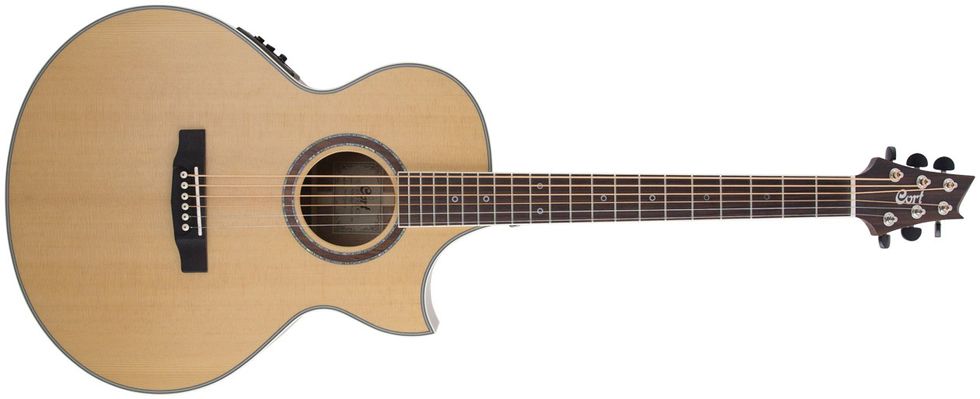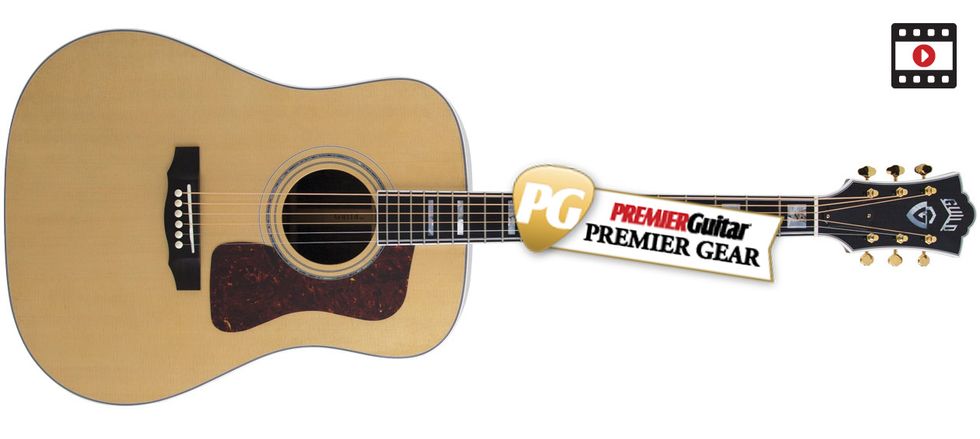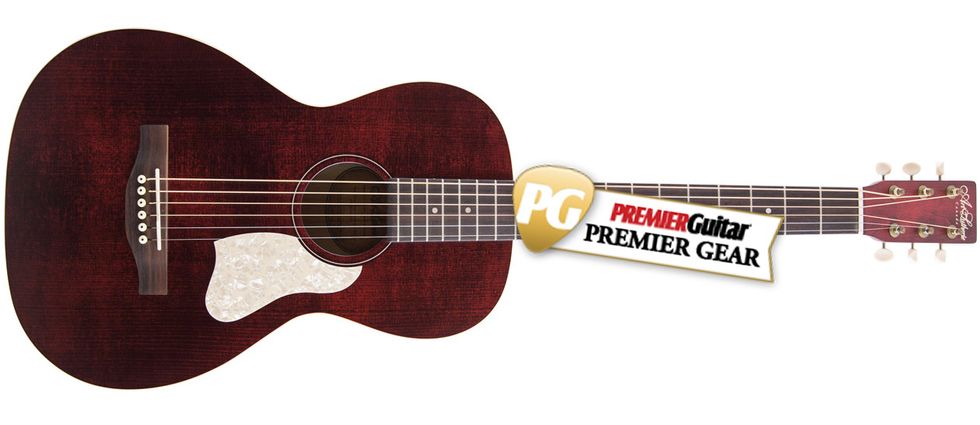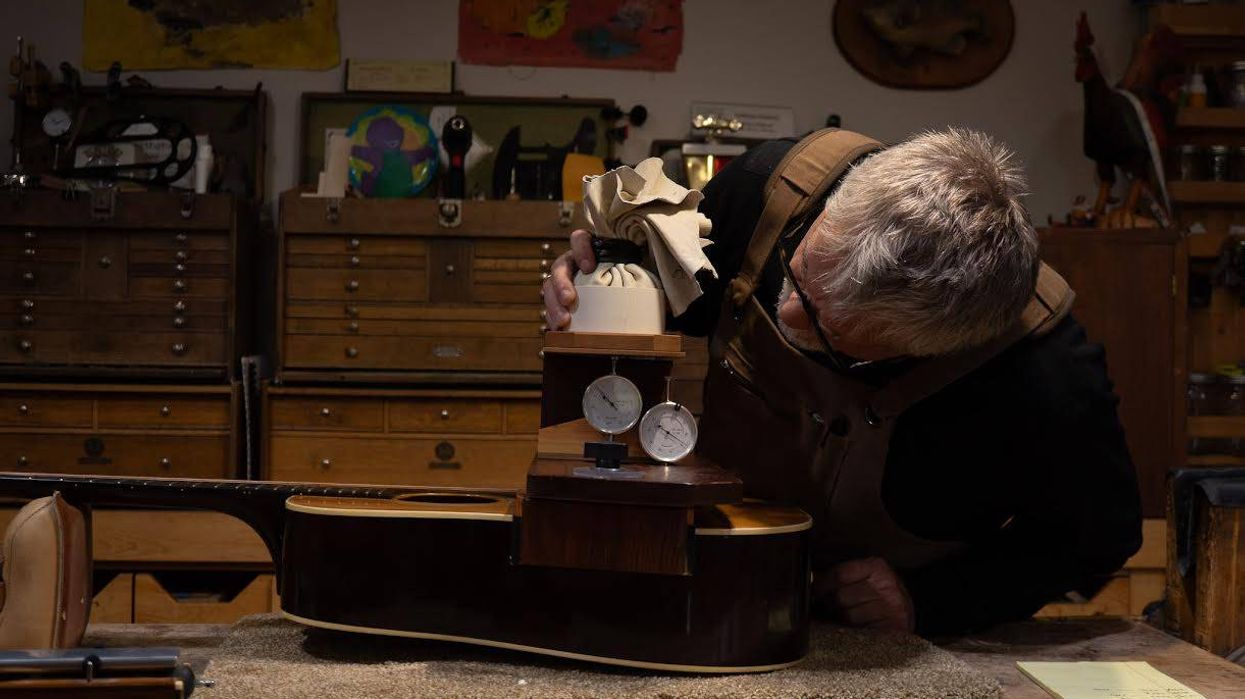It’s easy to forget—as you delve deep into the relative minutiae of 4- and 6-stage phasers, single-coils and humbuckers, and tube verses solid-state rectifiers—that acoustic flattops offer nearly as much variety and musical possibilities as their electronic cousins. That much should be clear just from a glance at the three acoustics in this roundup. From a petite-but-punchy parlor to a baritone bomber to a luxurious classic revived, this trio of instruments are, individually, very different animals. And in terms of feel, touch, and tone they each offer a thousand different musical departure points. Indeed, there’s no shortage of inspiration in these 18 strings. Read on and find out which of the acoustic lovelies would best aid your own musical quest.
Click next or click the review below you want to read first.
Cort NDX Baritone
Guild D-55
Art & Lutherie Roadhouse

Cort NDX Baritone
You know what’s weird about baritone acoustic guitar? The fact that more people don’t use it!
Tuning an acoustic guitar down a fourth or so below standard drops the instrument smack into cello register. Besides being an intrinsically attractive sound, the deeper tuning adds potent low-end thump to solo guitar performances. It also works brilliantly for acoustic duos. Besides adding bass mass, the altered tuning lets the players perform songs in different positions. (For example, having the standard-tuned guitarist play in G while the baritone player fingers the music in “C” or “D.”) This can add beguiling harmonic complexity to two-guitar performances, whether the music is intricate fingerstyle stuff or humble cowboy chords.
Not all players can afford several grand for a fine baritone acoustic if they’ve already invested in a top-flight standard-tuned acoustic. That’s what’s so attractive about budget-conscious Asian baritone acoustics from the likes of Alvarez and Ibanez, which sell for under $500. And now Cort has entered the market with a slightly more upscale acoustic bari: the $699 NDX.
Solid Stuff
The China-built NDX bari is a single-cutaway flattop with a built-in Fishman Presys preamp. With its 27"-scale fretboard and a lower bout that’s 16" wide by 5" deep, this is a sizeable axe. But it’s light, it balances nicely, and the deep Florentine cutaway makes it easy to access all 20 frets.
fundamental in your gut.
The top is solid Sitka spruce and the back is solid mahogany. The sides are mahogany laminate. The bridge and neck are mahogany as well, while the fretboard is rosewood. Cool cosmetic details complement the handsome woods, including a faux-abalone and mahogany rosette, neck/back/top binding, an asymmetrical headstock, and nifty black buttons on the Grover tuners. It’s a sharp-looking guitar.
It’s nicely made, too. The woods are pretty. The satin finish is consistent. The binding is immaculate. The interior work, with its scalloped X-bracing, is clean and glob-free. I’d have guessed this was a more expensive guitar, save for the rather rough fret ends, which are par for the price range.
Fret ends notwithstanding, NDX is relatively comfy thanks to a sleek, slender neck with a relaxed V profile. Still, plan on spending some time getting acclimated if you’re new to bari acoustic. The long scale means greater distance between the frets and, thanks to the larger string gauges, the nut width is 1.75". That may only be about 1/16" wider than most standard-tuned acoustics (it’s the norm for fingerstyle-oriented axes like Martin OMs), but it can be disorienting until you’ve played for a few hours. (Consider this an advisory more than a criticism.) The wider-than-usual string spacing and relatively heavy string gauges may also require some practice. But chances are you’ll be surprised how easy it is to manage those low strings, thanks to the slim neck and low action above the large frets.
Ratings
Pros:
Quality materials and workmanship. Nice tones, especially when played delicately. Good price.
Cons:
Heavy strumming can sound “splatty.” The long, wide fretboard may require acclimation time.
Tones:
Playability:
Build/Design:
Value:
Street:
$699
Cort NDX Baritone Acoustic-Electric
cortguitars.com
Bottom Feeder
When you pluck that low 6th string, you feel the fundamental in your gut. All low notes are taut and defined, and free of floppy wobble. Volume levels are balanced from register to register, with ample body, an attractive shimmer, and ear-engaging complexity.
The onboard Fishman system combines an under-saddle piezo with a miked signal. The unobtrusive control panel includes treble, mid, and bass controls, a feedback-nixing notch filter, phase reverse, mic/piezo blend, and a minimal yet effective tuner. My two demo clips feature the same performance. The first is the guitar’s natural sound through a high-end Schoeps small-diaphragm condenser mic. The second is the Fishman system alone. Naturally, the miked sound is more dynamic and nuanced, but the DI sound is perfectly workable for gigs.
From a Whisper to a Splat?
The guitar sounds especially attractive when played softly. Small variations in dynamics produce dramatic tone changes. Fingerstyle and plectrum playing both yield fine results. (The demo clip starts with a fingerstyle excerpt before I switch to a pick at 1:06.)
But the guitar responds best to a light touch. Heavy strumming seems to overload the instrument. Check out the final section of the clip (starting at 1:34), where I strum a repeated chord progression while transitioning from very quiet to very loud. After a certain point, chords seem to splat out, growing papery and compressed. Part of that may have to do with the laser-bright tones of coated phosphor/bronze factory strings.
The Verdict
Baritone acoustic guitar is a fine thing, and Cort’s NDX Baritone is a fine way to get there. Its materials and workmanship are terrific for its price range. Tones are attractive, and the guitar is sensitive to performance nuances, especially when played with some delicacy. Big, bold strumming is less successful to my ear (though darker-toned strings may help). But by any reckoning, this is a serious bang-for-buck guitar, and an excellent way to plumb new acoustic-guitar depths. —Joe Gore

Guild D-55
The best Guild guitars are cool and beautifully idiosyncratic instruments. And whether it was a modest mahogany M-20 or an opulent and orchestral-sounding F-212, my favorite Guild encounters made a big impression—leaving me with fond recollections of instruments with style, personality, and enrapturing sounds by the barrel load.
It doesn’t take long to hear the individuality in the new and resurrected U.S.-built D-55. It’s resonant, responsive, dynamic, and less booming than many rival dreads. And outwardly it suggests that Guild’s new custodians at Cordoba grasp the craft, style, and intangibles that made vintage Guilds special. It’s a beautiful convergence of art and function that’s very satisfying to play.
Goin’ Back to Cali
Guild’s history is dotted by enough factory moves and transfers of ownership to make a journeyman infielder’s career look stable. What I’ve always found interesting is how Guild’s sense of personality has remained more or less intact through those changes. The high-quality D-55 is another testament to the brand’s impressive resiliency and the way its legacy seems to inspire luthiers. When Cordoba Music Group bought Guild from Fender a few years back and moved production from Connecticut to Southern California, it wisely retained the services of wizard luthier Ren Ferguson. And though I don’t know the extent to which Ferguson is involved in assembly line supervision, the attention to detail you see in the D-55 certainly bears the mark of his influence.
of bossier dreads.
With a guitar this resplendent in binding and inlays, there are a lot of little details to screw up. But giving the D-55 a close-up once over, it’s hard to find anything even slightly amiss. The book-matched Indian rosewood back is beautifully finished and polished to reveal a rich and complex grain pattern, and is bisected by a maple and ebony dots-and-dashes back strip. The ABS binding that surrounds the body and neck is adorned with a super-thin black/white/black pinstripe that echoes the racing-stripe-like inlay that runs the length of either side of the fretboard.
Then there’s the beautiful “V-block” triangle-within-a-rectangle abalone inlays, which echo the abalone inlay in the headstock and rosette. The visual sum of these elements manages to be deeply luxurious without being ostentatious: a classic Guild design signature if there ever was one. Perhaps the only real design miscue is the plastic truss rod cover, which feels and looks insubstantial and chintzy for a guitar with this price tag.
Big but Balanced
Although dreadnoughts are the most popular acoustic body type, that doesn’t mean they are always the most versatile guitars. Often lacking the harmonic balance of orchestra and grand auditorium sized instruments, dreads can be boomy and lack dynamic range in fingerpicking situations. The D-55, however, is strikingly balanced from low registers to high. It’s responsive to a light touch, and is positively sparkling and present when I used a light pick for delicate hybrid picking. The same liveliness under light pick attack (and attack from light picks) gives buoyancy to capo’d chord phrasings and layered rhythm parts—qualities that will make the D-55 appealing to recording engineers that wrestle with the sonic mass of bossier dreads.
Ratings
Pros:
Unique, balanced voice. Killer chord machine. Superb playability and setup. Excellent build quality. Nice balance of fancy and un-fussy.
Cons:
Flatpickers may find individual notes too compressed and controlled.
Tones:
Playability:
Build/Design:
Value:
Street:
$2,999
Guild D-55 Natural
guildguitars.com
At times the D-55’s agreeability in low-volume situations does seem to come at the expense of the explosiveness that flatpickers demand from a dread. But if the D-55 lacks the cannon-like impact of a flatpicking standard bearer like a Martin D-28, the trade off is a very pleasing and welcome sense of balance at high volume and under high-intensity strumming and picking. Some of this balance comes from an almost compressed-sounding succinctness that you hear in individual notes. It’s an attribute that may frustrate macho bluegrass bullies. But in the context of vigorously strummed vocal backing, studio rhythm overdubs, or jazz-inflected picking chains and clusters, the individual notes translate to clear, beautiful chord voicings and a unique chiming quality that’s uncommon in dreadnoughts. And while predicting how a guitar will season is part speculation and part voodoo, I sense these qualities will improve as the wood matures.
The D-55’s bass output may lack some of the thump that classic rosewood-and-spruce dread players are accustomed to. But individual bass notes sustain beautifully and in lovely balance with midrange notes—adding up to a sound composite that lends sparkle to ornate fingerpicking filigree and a mellow resonance to alternating thumb-bass patterns.
A lot of the D-55’s dynamism (which can feel oddly paradoxical, given how compressed individual notes can sound) is attributable to its slinky playability. It's as good as any dread I remember playing. The action is low but the guitar stays relatively buzz free even when I strum hard with bass-string emphasis and use an extra-heavy pick. And though the guitar came strung with .012s, it felt positively elastic—inviting deep sustained bends, pull-offs, and hammer-ons that expand and extend its expressiveness. It’s also a much lighter guitar than some of its weighty ’70s predecessors.
The Verdict
Guild fans are usually iconoclasts in some measure. That’s a good thing when it comes to the D-55. Because while the new Guild’s quality may rival that from more high-profile builders, it bears a very different sonic signature than a popular classic like a J-45 or D-28. It may not be the loudest or most growling dread, but players geared toward dynamic modern styles, singer-songwriters, and studio engineers are bound to dig its civility and balance. At nearly three grand, it’s a serious investment. But it is similarly priced to many of its most obvious rivals—many of which are less luxuriously appointed. If you seek a sonic and visual difference from your next dreadnought, the D-55 could return that investment many times over as the years roll on. —Charles Saufley
Watch the Review Demo:

Art & Lutherie Roadhouse
At a distance, Art & Lutherie’s Roadhouse could be mistaken for a very old guitar. Its slim profile and narrow waist evoke the 1920s Gibson L-1, and its dark, grainy finish looks aged and rustic. But the little Roadhouse is a response to a very modern, resurgent interest in parlor guitars—the small-bodied flattops that reigned supreme before larger-bodied instruments, like the OM and the dreadnought, established dominance with their more powerful voices. And though the Roadhouse, with its Fishman electronics, puts a modern spin on things, it does have a warm, midrange-forward sound that’s well suited for old-timey Americana styles and beyond. Better still, the price is pretty old fashioned, too.
Cherry Picking
Art & Lutherie is a Godin family brand. Godin has long maintained an emphasis on North American construction and sustainably sourced woods, and the Roadhouse reflects adherence to these philosophies. The solid Sitka spruce top is paired with back and sides made from layered wild cherry and a silver-leaf maple neck, which are harvested from already fallen trees.
The Roadhouse is available in three different colors: bourbon burst, faded black, and Tennessee red. (Another option, faded cream, is available at retailers but not listed on A&L’s website.) Finished in Tennessee red, our review model looks awesome, and the grain in the book-matched back is oriented in a cool chevron pattern. While understated, the ivory-colored tuner buttons, binding, rosette, and bridge pins add a nice counterpoint to the deep red finish.
While the Roadhouse sells for less than five hundred bucks, A&L doesn’t seem to have cut any corners in construction. The frets are cleanly seated and polished, and the nut and compensated saddle, both Graph Tech Tusq, are tidily shaped and notched. There aren’t any defects in the guitar’s satin finish, and things are similarly ship-shape inside.
Easy on the Ears and Fingers
The Roadhouse is a sweet playing guitar. The neck is relatively slender in profile, but not overly so, and it feels welcoming over most of its length. At 24.84”, the scale length is on the short side for an acoustic guitar, but players who favor Gibson electrics will feel right at home on the neck.
As the compact body suggests, the guitar has a midrange-forward voice with solid fundamentals and subtle overtones. There’s a sweetness and richness to the sound as well that might be enhanced by the 12th-fret neck junction. (Compared to a 14-fret guitar, the bridge on a 12-fret typically sits at a position on the top that enhances low-end resonance.)
Ratings
Pros:
Solid-topped, North American–made guitar with a winning sound and style.
Cons:
Includes a gig bag and not a proper hardshell case.
Tones:
Playability:
Build/Design:
Value:
Street:
$449
Art & Lutherie Roadhouse
artandlutherieguitars.com
Fingerpicking a Scott Joplin rag and Robert Johnson’s “Terraplane Blues,” I was impressed by the guitar’s clarity and projection—which was almost certainly helped to some degree by the solid Sitka top and Adirondack spruce braces. Individual notes ring with satisfying attack and true intonation. The Roadhouse’s clarity lends itself to open G (for “Terraplane Blues”), open D, and DADGAD, too. It’s perfect for gentle arpeggio work with ringing open strings and harmonics, and the impressive sustain is also an asset when exploring these textures.
While the Roadhouse doesn’t exactly pack a wallop, it responds well when strummed with a pick in the boom-chuck style. The sound is crisp, with bass notes that are firm but not overpowering. It would definitely be a great choice in the studio for rhythm tracks.
When flatpicking, the Roadhouse sounds focused, if a tad polite. And I was sometimes left wanting just a little more power and grit. Then again, the Roadhouse—despite its name—seems much more about nuance.
The Roadhouse is outfitted with a Fishman Sonitone electronics package, which includes a Sonicore undersaddle pickup and a combo battery box and output jack. The preamp’s tone and volume controls are mounted out of sight at the top and underside of the soundhole. The battery compartment and jack sit at the lower bout.
Plugged into an AER Compact 60/3 amplifier, the Roadhouse sounds rich, punchy, and very natural. The electronics are noiseless and the guitar is largely resistant to feedback. The 6-string feels versatile plugged in, too. With the tone rolled back, it sounds almost like a jazz box.
The Verdict
Art & Lutherie’s Roadhouse is a fine-sounding, easy-playing parlor guitar with a cool midrange bark. The guitar’s Fishman electronics make it ready for gigs or for recording ideas on the fly. And with a street price of $449, the instrument represents a value that’s hard to beat. —Adam Perlmutter





















